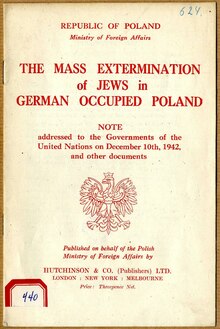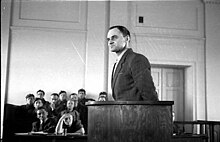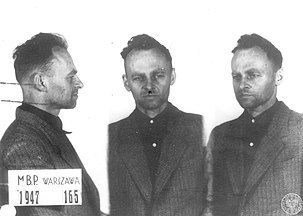Witold Pilecki
Witold Pilecki [ 'vitɔld pi'leʦki], code name : Roman Jezierski , Tomasz Serafinski , Druh and Witold (* 13. May 1901 in Olonets , Russian Empire ; † 25. May 1948 in Warsaw , Poland ), was an officer in the Second Polish Republic . During the Second World War he founded the resistance movement Tajna Armia Polska (German Secret Polish Army ) and was a member of the Armia Krajowa(German Home Army ). He was the only known person to voluntarily go into captivity at Auschwitz . There he organized the resistance of the inmates and as early as 1940 informed the Western Allies about the atrocities committed by the National Socialists in the camp. He fled in 1943 and took part in the Warsaw Uprising a year later . In 1948 a court of the People's Republic of Poland sentenced him to death for espionage in the course of the Stalinization of Poland and had him executed shortly afterwards. He was only rehabilitated after the end of the communist regime .
Life
Early life and first war experiences
Witold Pilecki was born on May 13, 1901 in Olonez on the shores of Lake Ladoga in Karelia , where his family had been forcibly resettled by Tsarist authorities after the January uprisings of 1863 and 1864 were put down. His grandfather Józef Pilecki had spent seven years in exile in Siberia because of his participation in the uprising . In 1910 Pilecki moved with his family to Wilno , where he finished his school days and joined the then secret scout group Związek Harcerstwa Polskiego (German Association of Polish Scouts , ZHP for short). In 1916 he moved to Oryol in central Russia , where he founded a local ZHP group.
During the First World War , Pilecki joined the Polish self-defense units in Vilnius in 1918 and, under the leadership of General Władysław Wejtka , helped collect weapons and disarm retreating, demoralized German troops. He then took part in the Polish-Soviet War between 1919 and 1920 . While serving under Major Jerzy Dąbrowski , he commanded a department of the ZHP. When his unit at the front was overrun by the Bolsheviks , they fought partisan battles behind enemy lines for a while. Pilecki later joined the regular Polish army and fought in a cavalry unit in the defense of Grodno . On August 5, 1920 he became a member of the 211th Uhlan Regiment and fought in the historic battle of the Vistula and in the Rudniki Forest (pln. Puszcza Rudnicka ) and was involved in the liberation of Vilna. For his bravery he was awarded the Cross of the Brave (pln. Krzyż Walecznych ) twice.
After the Polish-Soviet War, which ended with the Peace of Riga in 1921 , Pilecki graduated from high school in Vilnius and was demobilized in 1926 with the rank of cavalry ensign . Between the wars he worked on his family's farm in Sukurcze. On April 7, 1931, he married Maria Ostrowska (* 1906; † February 6, 2002). They had two children who were born in Vilnius, Andrzej (born January 16, 1932) and Zofia (born March 14, 1933).
At the beginning of the Second World War
Short mobilized before the start of World War II on August 26, 1939 acted in the Pilecki on the border with East Prussia marched Armia Prusy as commander of a cavalry column of the 19th Infantry Division . His unit was involved in the fighting during the attack on Poland and was partially wiped out. Pilecki's column withdrew in a south-easterly direction to Lemberg , where it was united with the 41st Infantry Division, which had been set up shortly before. During the attack on Poland, Pilecki and his men destroyed seven German tanks and shot down two planes. After starting from September 17, 1939 as a result of the Hitler-Stalin Pact , the Red Army that had occupied eastern Poland , Pilecki was disbanded unit, and he returned with his Major January Włodarkiewicz into German-occupied Warsaw back.
On November 9, 1939, the two men founded the Tajna Armia Polska (German Secret Polish Army , TAP for short), one of the first underground organizations in Poland. Pilecki became the organizational commander and expanded the TAP beyond Warsaw to Siedlce , Radom , Lublin and other large cities in central Poland. In 1940 the TAP had around 8,000 men (more than half of them armed), around 20 machine guns and various anti-tank rifles . The organization was later integrated into the Armia Krajowa (Pln. Home Army , AK for short) and formed into the core of the so-called Wachlarz unit.
The Auschwitz Campaign: 945 days
In 1940 Pilecki presented his superiors with the plan to be smuggled into Auschwitz I in Oświęcim , to gather information about the camp from inside and to organize the resistance of the inmates. Until now little was known about the German activities in the camp, which was thought to be an internment camp or a large prison. His superiors agreed to the plan and got him a fake passport called “Tomasz Serafiński”. On September 19, 1940, he voluntarily took to the streets in a raid (pln. Łapanka ) in Warsaw and was captured by the Germans along with 2,000 civilians (including Władysław Bartoszewski ). After two days of torture in a Wehrmacht barracks , the survivors were sent to Auschwitz. The inmate number 4859 assigned to him was tattooed on Pilecki's forearm .
While he worked in various commandos in Auschwitz and survived pneumonia , he organized the underground union of military organizations (pln. Związek Organizacji Wojskowej , or ZOW for short). The tasks of the ZOW included the improvement of the inmates' morale, the supply of messages from the outside, the procurement of additional food and clothing for the members, the establishment of message networks and train divisions around the camp in the event of a relief attack by the AK , the dropping of weapons from airplanes or a landing by the First Polish Independent Parachute Brigade stationed in Great Britain .
In 1941 ZOW had grown significantly. Members included the sculptor Xawery Dunikowski and the three-time Olympic Winter Games participant Bronisław Czech . The members worked in the camp administration of the SS (Rachwalowa, Rodziewicz, Olszowka, Jakubski and Miciukiewicz), the warehouses (Czardybun) and in the so-called Sonderkommando , which burned the corpses ( Dragon and Mandelbaum ). The organization also had an underground court and supply lines to the outside world. Thanks to the people who lived in the neighborhood, she received regular medical supplies.
The ZOW provided the Polish underground with information about the camp and the activities of the Germans there. Many smaller underground organizations in Auschwitz allied with the ZOW. In the autumn of 1941, Colonel Jan Karcz was brought to the newly established Auschwitz-Birkenau extermination camp just a few kilometers away , where he continued building up the structures of the ZOW. In the spring of 1942 the organization had more than 1,000 members in most of the sub-camps, including women, Czechs and Jews . The inmates built a radio receiver and hid it in the camp hospital.
From October 1940 the ZOW sent reports to Warsaw, and from March 1941 Pilecki's reports on the Polish resistance movement were sent to the British government in London . Pilecki hoped that either the Allies would bring weapons or troops into the camp, or that the Home Army would organize an outside attack. In 1943, however, he realized that no such plans existed. In the meantime, the Gestapo redoubled its efforts to track down members of the ZOW. Pilecki decided to flee the camp in the hope of personally convincing the Home Army leaders that attempting a rescue was an option. When he was assigned to a night shift in the camp bakery outside the fence, he and two comrades overpowered the guard, cut the telephone line and fled on the night of April 26-27, 1943 with documents that he had stolen from the Germans If they were arrested, they were willing to swallow cyanide to prevent the Germans from finding out what they knew. After a few days, with the help of the local population, they managed to escape from the area and contacted the Home Army units. Pilecki wrote another detailed report on the conditions in Auschwitz. He was promoted to first lieutenant on November 11, 1941.
The later SED cadre Bruno Baum only mentions Pilecki in the first edition of his experience report from the 1949 concentration camp, and in a condescending way:
“Certainly there were difficulties from time to time, due to the fact that many a Polish cavalry lieutenant who was in the concentration camp believed that the liberation of Poland would have to come from him, sat down, worked out a plan and now tried to carry it out in all possible ways. "
After further negative remarks about the Polish forces in exile in London as a whole, he came to a conciliatory conclusion: "We still managed to work with all of these forces."
Warsaw Uprising
On August 25, 1943, Pilecki arrived in Warsaw and joined the Home Army as a member of the intelligence department. After losing several functionaries while exploring the area around the camp, including the Cichociemni commander Stefan Jasieński , the latter decided that without the help of the Allies, they would not be strong enough to take the camp. Pilecki's detailed report ( Raport Witolda ) was sent to London. The British authorities refused to provide air support for an operation to help the inmates escape. An air strike was deemed too risky and the Home Army reports of the Nazi atrocities were viewed as exaggerations. Pilecki had written: "During the first three years two million people disappeared in Auschwitz, in the following two years three million."
Pilecki was soon promoted to captain of the cavalry ( Rotmistrz ) and a member of the secret anti-communist organization NIE (pln. For "no", as well as an abbreviation for Niepodległość "independence"), which should prepare the resistance against an impending Soviet occupation within the Home Army.
When the Warsaw Uprising broke out on August 1, 1944, Pilecki was a volunteer with the Chrobry II group. At first he fought in the northern city center, without revealing his rank, as a simple soldier. He later revealed his true identity and took command of the 2nd Company fighting on Towarowa and Pańska Streets. His forces held a fortified area called the "Great Bastion of Warsaw". It was one of the most remote partisan entrenchments and caused considerable difficulties for the German supply lines. The bastion withstood the constant attacks of the German infantry and tanks for two weeks.
After the surrender of the uprising, Pilecki hid a supply of weapons in a private apartment and surrendered to the Wehrmacht on October 5, 1944. He was sent to Germany and imprisoned in the Lamsdorf internment camp , a prisoner of war camp near Lamsdorf in Silesia . He was later transferred to Oflag VII A in Murnau am Staffelsee , where he was finally liberated on April 28, 1945 by troops of the US 12th Armored Division .
Persecution and murder in Soviet-occupied Poland
He left Murnau on July 11, 1945 and was transferred to the military intelligence department of the Polish II Corps under General Władysław Anders in Ancona . There he received orders to secretly move a large amount of money to Soviet-occupied Poland, but the operation was canceled. In September 1945, General Władysław Anders ordered him to return to Poland and collect news for the West.
He went back and continued to build his news network while at the same time writing a monograph on Auschwitz . In the spring of 1946, however, the Polish government in exile decided that there was no hope of the liberation of Poland in the political situation after the war and ordered all partisans still in the woods to either return to their bourgeois life or to flee to the West . Pilecki refused to leave the country and dealt with disbanding the partisans in eastern Poland.
In April 1947 he began collecting evidence of Soviet atrocities as well as the persecution of Poles (especially members of the Home Army and the soldiers of the Polish Armed Forces who had returned from exile in the West ) and their execution or imprisonment in the Soviet gulag .
On May 8, 1947 he was arrested by the Polish communist secret service Urząd Bezpieczeństwa (German Security Office ). He was repeatedly tortured before the trial but did not reveal any classified information and tried to protect other prisoners. On March 3, 1948, a show trial took place in which many, probably forged documents were used as evidence. Evidence against Pilecki was presented by the future Polish Prime Minister Józef Cyrankiewicz , himself an Auschwitz survivor and now a member of the nomenklatura of Stalinized Poland. Pilecki was charged with espionage for the Western Allies and General Anders. On May 15, he was sentenced to death with three comrades . Ten days later he was executed in Mokotów Prison .
Pilecki's conviction was based on false allegations and evidence and was part of the persecution of members of the Home Army and other allies of the Polish government-in-exile in London. In 2003 the prosecutor and several other parties involved in the trial were convicted of complicity in Pilecki's murder. Cyrankiewicz had died in 1989. Pilecki was not rehabilitated until October 1, 1990. His tomb was never found; he was probably buried in a garbage dump near the Powązki Cemetery in Warsaw. Until 1989 information about his deeds and fate was suppressed by the communist regime of Poland.
On September 6, 2013, Witold Pilecki was posthumously promoted to colonel.
Photographs by Witold Pilecki in the Mokotów prison in 1947
Awards
- Knight of the Order of the White Eagle ( posthumous , 2006)
- Officer of the Order of Polonia Restituta (posthumous, 1995)
- Honorary Citizenship of the City of Warsaw (posthumously, 2009)
- Cross of Valor (Poland) , awarded twice
- Silver Cross of Merit of the Republic of Poland (1938)
- Cross of Merit for Central Lithuania
- War medal 1918–1921
- The decade of regained independence
- Auschwitz Cross (posthumous)
- Warsaw Rising Cross
- Star of Perseverance (posthumous)
- Righteous Among the Nations (posthumous)
Witold Pilecki as namesake
- State Rittmeister Witold Pilecki University in Oświęcim
- Rittmeister-Witold-Pilecki-Medal, the highest award of the State Rittmeister-Witold-Pilecki-Hochschule Oświęcim
- In 2008, the Pilecki Park in Zabrze was named in his honor.
- Numerous streets in Poland are named after Witold Pilecki.
plant
- WP: The Auschwitz Volunteer: Beyond Bravery . Translated by Jarek Garlinski. Aquila Polonica, 2012, ISBN 978-1-60772-010-2 , ISBN 978-1-60772-009-6 (his original reports in a translation)
- Polish original at the Polish Underground Movement Study Trust, London
- German version: WP, Voluntary to Auschwitz. The secret records of the inmate Witold Pilecki Translated from the English Dagmar Mallett. Orell Füssli, Zurich 2013, 256 pp. ISBN 978-3-280-05511-3 (Review: Jochen August, in: Insight. Bulletin of the Fritz Bauer Institute . No. 11. Frankfurt, 2014 (spring) ISSN 1868- 4211 p. 79f.)
literature
- Edward Ciesielski: Wspomnienia Oświęcimskie. [Auschwitz Memoirs] Kraków 1968 (Polish).
- Adam Cyra, Wiesław Jan Wysocki: Rotmistrz Witold Pilecki. Oficyna Wydawnicza VOLUMEN, 1997; ISBN 83-8685-727-7 (Polish).
- Adam Cyra: Spadochroniarz Urban. Oświęcim 2005 (Polish)
- Adam Cyra: Ochotnik do Auschwitz: Witold Pilecki. Chrześcijańskie Stowarzyszenie Rodzin Oświęcimskich [Christian Association of Auschwitz Families], Oświęcim [Auschwitz] 2000, ISBN 83-912000-3-5 ISBN 8391200043 (Polish, 430 pages)
- Jack Fairweather : The Volunteer: The True Story of the Resistance Hero Who Infiltrated Auschwitz . London: WH Allen, 2019
- Józef Garliński: Fighting Auschwitz. The Resistance Movement in the Concentration Camp. Fawcett, 1975; ISBN 0-449-22599-2 (English, reprint: Time Life Education, 1993, ISBN 0-8094-8925-2 ).
- Wincenty Gawron, Ed .: Ochotnik do Oświęcimia. ["Volunteer in Auschwitz"] Calvarianum, Auschwitz Museum, Oświęcim 1992, ISBN 8385047034 (Polish, with 280 pages).
- Jon E. Lewis: The Mammoth Book of True War Stories. Carroll & Graf Publishers, 1999, ISBN 0-786-70629-5 Google Print, p.389 + (English).
- Konstanty Piekarski: Escaping Hell. The Story of a Polish Underground Officer in Auschwitz and Buchenwald. Dundurn Press, 1990, ISBN 1-550-02071-4 (English).
- Wiesław Jan Wysocki: Rotmistrz Pilecki. ["Rittmeister Pilecki"] Pomost 1994, ISBN 8-385-20942-5 (Polish).
Web links
- Instytut Pamięci Narodowej : Captain Pilecki. In: pilecki.ipn.gov.pl. July 1, 2013, accessed September 1, 2019 .
- Pilecki's Auschwitz report online in German
- Resistance in Auschwitz, Pilecki's role in German
- Publications by and about Witold Pilecki at Litdok East Central Europe / Herder Institute (Marburg)
- Mathias Plüss: Voluntarily in Auschwitz. In: one day , June 10, 2013.
- Knud von Harbou : The man who voluntarily went to Hell at Auschwitz. In: Süddeutsche Zeitung of February 4, 2014
- Voluntarily to the concentration camp (brief overview of Pilecki's photographs from the Auschwitz concentration camp file, taken by Wilhelm Brasse ), spiegel.de, January 12, 2015
References
- ↑ Bruno Baum: Resistance in Auschwitz. Report of the international anti-fascist camp leadership ; VVN Berlin 1949; P. 32. In the expanded edition from 1962 the section that it should be on p. 86 is missing.
- ↑ Florian Hassel: Turning maneuver for Poland's streets. Alleys, squares and bridges will be renamed according to the will of the national conservative government . In: Süddeutsche Zeitung of January 2, 2018, p. 6.
| personal data | |
|---|---|
| SURNAME | Pilecki, Witold |
| BRIEF DESCRIPTION | Polish soldier, resistance fighter |
| DATE OF BIRTH | May 13, 1901 |
| PLACE OF BIRTH | Olonez , Russian Empire |
| DATE OF DEATH | May 25, 1948 |
| Place of death | Warsaw , Poland |






